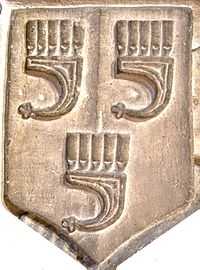Clarion (heraldry)


The clarion, (alias clarichord, clavicord, organ rest,[1] horseman's rest or rest) is a rare charge in heraldry of uncertain origin and purpose. In Canadian heraldry, it is the cadency mark of a ninth daughter.
It is generally said to represent a musical instrument such as a panpipe, organ or recorder, but does not resemble the trumpet-like clarion known to modern musicians. Alternatively it has been said to represent a "rest", a device used by mediaeval knights to support a lance during jousting. To add to the confusion, "Claricord" is now the brand name of an adjustable neckstrap used to support the weight of a clarinet.[2]
The use of this word for an instrument resembling a panpipe or clarion horn suggests it was a wind instrument. However, Webster's Dictionary defines it as a string-instrument as follows (clearly not the object represented in heraldry, as a spinet is a large, heavy instrument resembling a small upright piano, with no resemblance to panpipes or trumpets at all):
1828 edition: CLARICHORD, n. A musical instrument in form of a spinet, called also manichord. It has forty nine or fifty stops or keys, and seventy strings; some of the latter being in unison. There are several little mortises for passing the jacks, armed with brass hooks, which stop and raise the chords, instead of the feather used in virginals and spinets. The chords are covered with pieces of cloth, which deaden the sound and render it sweeter. Hence it is particularly used by nuns.[3]
1913 edition: Clar"i*chord (?), n. [F. clatocorde, fr.L. clarus clear + chorda string. See Chord.] A musical instrument, formerly in use, in form of a spinet; -- called also manichord and clavichord.[4]
Clarion is also the label for a stop on an organ which imitates the sound of a trumpet.
A verse of poetry published in 1568 does not do much to clarify the issue:The claricord hath a tunely kynde
As the wyre is wrested hye and lowe
Yet blame not the claricord the wrester doth wrong.[5]
So it tuenyth to the players mynde
For as it is wrested so must it nedes showe
As by this reson ye may well know
Any Instrument mystunyd shall hurt a trew song
Translation:
The claricord has a tuneful nature
As the wire is tightened high and low
Yet blame not the claricord the tuner does wrong.
Thus is it tuned to the player's mind
For as it is tightened, so it must go
And by this reason, you must know
Any instrument mistuned shall hurt a true song
External links
| Wikimedia Commons has media related to Category:Clarions in heraldry. |
- Clarion: illustration and discussion by François Velde. Accessed March 6, 2010.
- Clarion, Claricord, Organ Rest, Rest, Sufflue: illustration and brief description. Accessed March 6, 2010.
- The Meanings Behind the Symbols: Clarion: heraldic charge illustrated, and interpreted as meaning "ready for war." This meaning is compatible with the idiom clarion call, meaning an irresistible summons (as to war). Accessed March 6, 2010.
- Coats of arms of Case Western Reserve University and its predecessors. The description of the arms used by the School of Applied Science / Case Institute of Technology (1942–1967) states in part:
[T]he clarion (with bells rather than pipes), an ancient musical instrument, "recognized the inclusion of the classics, and the various cultural subjects in the curriculum."
The quote within the quote is presumably from the original designer of these arms. Accessed March 6, 2010.
References
- ↑ Blazoned as "organ rest" by Debrett's Peerage, 1968, p.510 for Baron Grenfell
- ↑ Neckstraps and Other Clarinet Supports by Eric Tishkoff. Accessed January 20, 2007.
- ↑ Webster's "Clarichord" in Noah Webster's 1828 Dictionary, Electronic edition maintained by Christian Technologies, Inc. Accessed January 20, 2007.
- ↑ "Clarichord" at p. 261 of Webster's Dictionary, 1913 edition, maintained online by the ARTFL Project. Accessed January 20, 2007.
- ↑ Texts on Music in English reprinted by the Center for the History of Music Theory and Literature of the University of Nebraska and Indiana University. Accessed January 20, 2007.